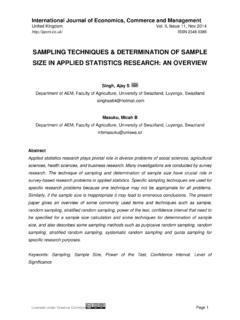Transcription of Introduction to Applied Linear Algebra
1 Introduction to Applied Linear Algebra Vectors, Matrices, and Least Squares Stephen Boyd Department of Electrical Engineering Stanford University Lieven Vandenberghe Department of Electrical and Computer Engineering University of California, Los Angeles University Printing House, Cambridge CB2 8BS, United Kingdom One Liberty Plaza, 20th Floor, New York, NY 10006, USA. 477 Williamstown Road, Port Melbourne, VIC 3207, Australia 314 321, 3rd Floor, Plot 3, Splendor Forum, Jasola District Centre, New Delhi 110025, India 79 Anson Road, #06 04/06, Singapore 079906.
2 Cambridge University Press is part of the University of Cambridge. It furthers the University's mission by disseminating knowledge in the pursuit of education, learning, and research at the highest international levels of excellence. Information on this title: DOI: Cambridge University Press 2018. This publication is in copyright. Subject to statutory exception and to the provisions of relevant collective licensing agreements, no reproduction of any part may take place without the written permission of Cambridge University Press.
3 First published 2018. Printed in the United Kingdom by Clays, St Ives plc, 2018. A catalogue record for this publication is available from the British Library. ISBN 978-1-316-51896-0 Hardback Additional resources for this publication at Cambridge University Press has no responsibility for the persistence or accuracy of URLs for external or third-party internet websites referred to in this publication and does not guarantee that any content on such websites is, or will remain, accurate or appropriate. For Anna, Nicholas, and Nora Danie l and Margriet Contents Preface xi I Vectors 1.
4 1 Vectors 3. Vectors .. 3. Vector addition .. 11. Scalar-vector multiplication .. 15. Inner product .. 19. Complexity of vector computations .. 22. Exercises .. 25. 2 Linear functions 29. Linear functions .. 29. Taylor approximation .. 35. Regression model .. 38. Exercises .. 42. 3 Norm and distance 45. Norm .. 45. Distance .. 48. Standard deviation .. 52. Angle .. 56. Complexity .. 63. Exercises .. 64. 4 Clustering 69. Clustering .. 69. A clustering objective .. 72. The k-means algorithm .. 74. Examples .. 79. Applications.
5 85. Exercises .. 87. viii Contents 5 Linear independence 89. Linear dependence .. 89. Basis .. 91. Orthonormal vectors .. 95. Gram Schmidt algorithm .. 97. Exercises .. 103. II Matrices 105. 6 Matrices 107. Matrices .. 107. Zero and identity matrices .. 113. Transpose, addition, and norm .. 115. Matrix-vector multiplication .. 118. Complexity .. 122. Exercises .. 124. 7 Matrix examples 129. Geometric transformations .. 129. Selectors .. 131. Incidence matrix .. 132. Convolution .. 136. Exercises .. 144. 8 Linear equations 147.
6 Linear and affine functions .. 147. Linear function models .. 150. Systems of Linear equations .. 152. Exercises .. 159. 9 Linear dynamical systems 163. Linear dynamical systems .. 163. Population dynamics .. 164. Epidemic dynamics .. 168. Motion of a mass .. 169. Supply chain dynamics .. 171. Exercises .. 174. 10 Matrix multiplication 177. Matrix-matrix multiplication .. 177. Composition of Linear functions .. 183. Matrix power .. 186. QR factorization .. 189. Exercises .. 191. Contents ix 11 Matrix inverses 199. Left and right inverses.
7 199. Inverse .. 202. Solving Linear equations .. 207. Examples .. 210. Pseudo-inverse .. 214. Exercises .. 217. III Least squares 223. 12 Least squares 225. Least squares problem .. 225. Solution .. 227. Solving least squares problems .. 231. Examples .. 234. Exercises .. 239. 13 Least squares data fitting 245. Least squares data fitting .. 245. Validation .. 260. Feature engineering .. 269. Exercises .. 279. 14 Least squares classification 285. Classification .. 285. Least squares classifier .. 288. Multi-class classifiers.
8 297. Exercises .. 305. 15 Multi-objective least squares 309. Multi-objective least squares .. 309. Control .. 314. Estimation and inversion .. 316. Regularized data fitting .. 325. Complexity .. 330. Exercises .. 334. 16 Constrained least squares 339. Constrained least squares problem .. 339. Solution .. 344. Solving constrained least squares problems .. 347. Exercises .. 352. x Contents 17 Constrained least squares applications 357. Portfolio optimization .. 357. Linear quadratic control .. 366. Linear quadratic state estimation.
9 372. Exercises .. 378. 18 Nonlinear least squares 381. Nonlinear equations and least squares .. 381. Gauss Newton algorithm .. 386. Levenberg Marquardt algorithm .. 391. Nonlinear model fitting .. 399. Nonlinear least squares classification .. 401. Exercises .. 412. 19 Constrained nonlinear least squares 419. Constrained nonlinear least squares .. 419. Penalty algorithm .. 421. Augmented Lagrangian algorithm .. 422. Nonlinear control .. 425. Exercises .. 434. Appendices 437. A Notation 439. B Complexity 441. C Derivatives and optimization 443.
10 Derivatives .. 443. Optimization .. 447. Lagrange multipliers .. 448. D Further study 451. Index 455. Preface This book is meant to provide an Introduction to vectors, matrices, and least squares methods, basic topics in Applied Linear Algebra . Our goal is to give the beginning student, with little or no prior exposure to Linear Algebra , a good ground- ing in the basic ideas, as well as an appreciation for how they are used in many applications, including data fitting, machine learning and artificial intelligence, to- mography, navigation, image processing, finance, and automatic control systems.
